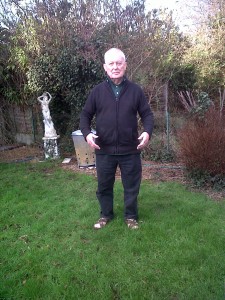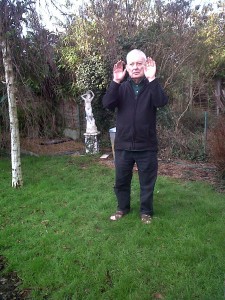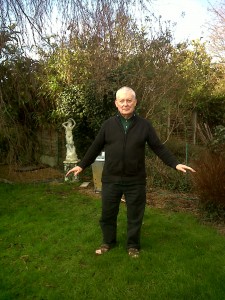(Nurses learn a practical procedure in the classroom circa 1950 – Google)
Recent posts on meditation and again on mysticism have provided a scaffold on which to arrange my thoughts about both, and appraise them a little. In Meditation 4 I had something to say about possible alternatives to sitting meditation, including a practice I favour: “Standing Like A Tree”, a kind of yoga.
I shall now briefly address the issue of “introverted attention” and “extroverted attention”, as these terms seem to apply to, and perhaps differentiate, two rather different meditation practices, two different methods of meditating, perhaps subserving two different purposes and leading to two different outcomes.
“Introverted attention” or the “inward way” usually occurs within a religious or doctrinal context, the method set out in teachings or texts, follows tradition, and involves a specific decision or a set of decisions, and a commitment to continuing practice.
Methodologically, the meditator goes to a quiet place, adopts a cross sitting legged position, eyes closed or half-closed, and focusses attention on some chosen sense object, usually the breath or some component of breath, such as the sensations at the nostrils. The starting-out object (and the possible result) is separation from sensuality, the quieting of discursive thought, some tranquillity, and perhaps an experience of pleasure and zest.
“Introverted attention” has as its purpose (if it is deemed to have any purpose) as the ultimate attainment of “contentless experience” – a state of consciousness totally devoid of sensory input, memory, discursive thought, feeling, emotion etc. A committed practitioner may attain by increments to a state of ‘contentless experience’ by moving through an ascending scale of states, each of which contains less content than the preceding one. Perhaps modesty forbids that meditators lay claim to attainment of any position on the notional scale, I don’t know. But I do wonder how any such attainment would ‘spin off’ into action that impacted the world, and how we could recognise it, and learn from it.
“Extroverted attention”, again as I understand it, means “going outward” and may be called the “outward way”. In contrast to the “inward way” it involves much less methodological consistency, and may “grow like Topsy” out of the routine activities of everyday life and workaday situations, without a specific decision to practice, or any purpose beyond the utilitarian, such as learning a skill necessary to do a job.
Later on in this article I’ve included some nursing notes that – to my mind – conduce incidentally to “extroverted attention”; but I don’t think that they were intended to develop extroverted attention beyond their prosaic remit, and don’t exist within a recognisable religious or philosophical context. I’m not making any special claim for them, but they may interest and intrigue you, as they do me.
Unlike the techniques of “introverted attention”, the “extroverted attention”practitioner (for want of a word to describe everywoman/everyman at large) has her eyes open, and is open to all her senses and all her immediate experience, including her orientation in space and time, her posture, her movements, and the physical presence of proximate objects and life-forms. The lens of her experience is widely open, and takes in ‘the big picture’, while able to discriminate detail as well, notice change, and to act appropriately to it.
Paradoxically perhaps, she is relatively free from discursive thought, although she may have internalised a series of mental cues and prompts that operate at a level just below the horizon of conscious awareness, and are accessible as thoughts by a small act of intention, like a voluntary blink.
In “extroverted attention” her personal boundary seems to expand, and to become more and more permeable and blurred, so that the subject-object distinctions lose their valency. It is, perhaps, in this way that the pianist’s fingers become one with the keys, the seamstress’s fingers with her needle and threads, the surgeon’s with her scalpel and the organ it incises; the jockey with his horse.
Because the aperture of attention is limitless, so the idea of an aperture between observer and observed is (as if) meaningless. The distinction between carer and cared-for is also lost, as is the notion of compassion as something that flows from one vessel to another, as if from an unidirectional nozzle. Compassion can’t be contrived, but it can be apprehended as a stream of meaning in which both ‘carer’ and ‘cared-for’ are immersed, and in which their reciprocal agency is engaged ‘as one’.
I think there is always a question in the air about which meditation practice is ‘best’, and perhaps that question begs the question “Best for what?”. For me (and please challenge me on this) I might argue that weighing the “inward way” against the “outward way” is like assessing the relative merits of breathing in and breathing out: the answer does rest/doesn’t rest on what’s the purpose of breathing at all……
PRACTICAL NURSING NOTES (circa 1955) – edited extracts
*************
Performing a blanket bath or bed bath is an important nursing duty, not to be shirked by a nurse on grounds of her seniority, or because she may be called to more pressing duties. A senior nurse will remind herself of her duty to teach and supervise her junior in the performance of such duties; she will pride herself in passing on her knowledge, skill and especially her dexterity, her economy of movement, and her powers of observation to another, thus kindling her charge’s enthusiasm for excellence in bedside nursing care; encouraging her devotion to the nursing art; and earning her professional respect.
Aside from its importance in maintaining a level of personal hygiene – vital for health, for self-respect and for dignity, and the prevention of the secondary infections and decubitus ulcers (bedsores) associated with prolonged bed rest – the skilfully administered blanket bath confers a profound feeling of well-being on the patient, and helps him to develop trust and confidence in his nurse. This sense of security is necessary for the confidential exchange of information between patient and nurse, in order that she may build up a picture of his progress, its adequacy in response to his treatment and care, and any hindrances to progress that will need attention by the physician.
***************
Having collected the requisite equipment, lay up a bath-trolley (which should be scrupulously clean) as follows:
Top shelf: enamel bowl, large enamel water jug containing water at 45 degrees Celsius; large receiver or kidney dish containing two body flannels, suitably sized portion of white unperfumed soap, unperfumed talcum powder (the patient’s own talcum powder may be used if he permits its use), surgical spirit in sprinkler bottle, large enamel bowl of coarse tow or brown wool for peri-anal toilet, small receiver or kidney dish containing a nail brush, nail-scissors, a hair brush and comb; small bowl or receiver containing an enamel mug for mouth-wash.
Lower shelf: Enamel bucket for used water; large enamel water jug containing water at 60 degrees Celsius; bedpan and/or urinal and sanitary cover; toilet tissue; bath thermometer; strong paper bag for disposal of used tow or brown wool; two large bath towels and a face towel; change of night attire or gown; change of bed linen (normally one draw sheet, one bed sheet and one pillow case); one flannel bath blanket.
*****************
Check the contents of the trolley carefully before proceeding to the bedside to prepare the patient and the environment for the procedure.
Inform the patient about what you intend to do and so as to ensure his willing cooperation. Close the nearby windows to exclude draughts and screen the bed or close the bed-curtains.
*****************
Carefully assist the patient in the removal of his night-clothing, taking care to preserve his dignity and privacy. The nurse’s movements and gestures will be well-considered, economical, unhurried, firm, gentle; they will inspire confidence and they will reassure; nurse will have full attention for any indication in the patient’s response that her support is the occasion of any alarm, discomfort or his unwillingness to proceed.
******************
When washing the upper limbs, begin with the arm distal to the ministering nurse. Ensure that the proximal arm and chest are covered so as to avoid drips. Wash the exposed arm from the shoulder down its length with a soaped cloth, using long firm strokes from above to the tips of the fingers, giving careful attention to between the fingers, and to skin creases and folds. Note the condition of the nails and cuticles. Rinse the wash-cloth and repeat the washing action to remove all suds, then dry the limb and hand carefully and cover with the flannel blanket to prevent chilling.
********************
At the end of a skilfully-performed blanket bath, it is not unusual for the patient to drop into a peaceful sleep, waking refreshed after a short interval. Nurse will plan her procedure to take this into account, especially if the blanket bath is administered less than hour before a main meal is served.













